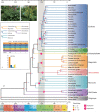Chloranthus genome provides insights into the early diversification of angiosperms
- PMID: 34836973
- PMCID: PMC8626473
- DOI: 10.1038/s41467-021-26922-4
Chloranthus genome provides insights into the early diversification of angiosperms
Abstract
Chloranthales remain the last major mesangiosperm lineage without a nuclear genome assembly. We therefore assemble a high-quality chromosome-level genome of Chloranthus spicatus to resolve enigmatic evolutionary relationships, as well as explore patterns of genome evolution among the major lineages of mesangiosperms (eudicots, monocots, magnoliids, Chloranthales, and Ceratophyllales). We find that synteny is highly conserved between genomic regions of Amborella, Vitis, and Chloranthus. We identify an ancient single whole-genome duplication (WGD) (κ) prior to the divergence of extant Chloranthales. Phylogenetic inference shows Chloranthales as sister to magnoliids. Furthermore, our analyses indicate that ancient hybridization may account for the incongruent phylogenetic placement of Chloranthales + magnoliids relative to monocots and eudicots in nuclear and chloroplast trees. Long genes and long introns are found to be prevalent in both Chloranthales and magnoliids compared to other angiosperms. Overall, our findings provide an improved context for understanding mesangiosperm relationships and evolution and contribute a valuable genomic resource for future investigations.
© 2021. The Author(s).
Conflict of interest statement
The authors declare no competing interests.
Figures




References
-
- Li H, et al. Origin of angiosperms and the puzzle of the Jurassic gap. Nat. Plants. 2019;5:461–470. - PubMed
-
- Sun G, Dilcher DL, Wang H, Chen Z. A eudicot from the early cretaceous of China. Nature. 2011;471:625–628. - PubMed
-
- Steemans P, et al. Origin and radiation of the earliest vascular land plants. Science. 2009;324:353–353. - PubMed
-
- Friedman WE. The meaning of Darwin’s “abominable mystery”. Am. J. Bot. 2009;96:5–21. - PubMed
Publication types
MeSH terms
Substances
LinkOut - more resources
Full Text Sources

